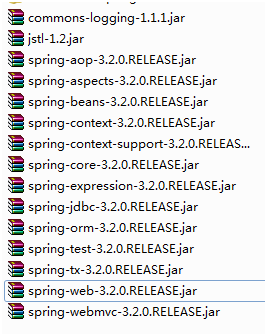1、思路和想法。
目前理解到的,觉得是的,可能的,应该这样的………………
Spring的两大核心是IoC和AOP
Ioc:帮助实例化对象,加载到容器中,在注入到需要用到的地方。这样就可以减少在不同的方法/类中新建对象了。同时,实现类改变了(基于接口),在xml中改了就好。比较适合单例编程。那么我们将Hibernate常常用到的SessionFactory交给Spring。
AOP:与数据库打交道,事务管理是必须的,什么ACID之类的。那么AOP就比较适合了。
2、整合
继续在之前的工程加上spring的jar。
1)、Spring-3.2.0

2)、使用数据源。
选用dbcp
commons-dbcp-xxx.jar
commons-pool-xxx.jar

3)、SessionFactory
在spring的配置文件中,配置SessionFactory(交给Spring)管理。Spring配置文件这里命名为applicationContext.xml

1 <!-- sessionFactory --> 2 <bean id="sessionFactory" 3 class="org.springframework.orm.hibernate4.LocalSessionFactoryBean"> 4 <!-- 数据源 --> 5 <property name="dataSource" ref="dataSource" /> 6 <!-- 注解的实体类 ,扫描包 --> 7 <property name="packagesToScan"> 8 <list> 9 <value>com.xzw.ssh.pojo</value> 10 </list> 11 </property> 12 13 <!-- sessionFactory的一些其他设置。 --> 14 <property name="hibernateProperties"> 15 <props> 16 <!-- 通过getCurrentSession创建的session会绑定到当前线程 --> 17 <prop key="current_session_context_class">thread</prop> 18 <!--方言 --> 19 <prop key="dialect">org.hibernate.dialect.MySQLDialect</prop> 20 <!--输出sql --> 21 <prop key="hibernate.show_sql">true</prop> 22 <!-- sql格式化输出--> 23 <prop key="hibernate.format_sql">true</prop> 24 </props> 25 </property> 26 </bean>
4)、mysql.properties
连接到数据库的基本属性。本测试放在classpath下的db文件
jdbc.driver=com.mysql.jdbc.Driver
jdbc.url=jdbc:mysql://localhost:3306/nwssh
jdbc.username=root
jdbc.password=root
5)、datasource的xml配置。
在applicationContext.xml加上。

1 <!-- 加载配置文件 db/mysql.properties --> 2 <context:property-placeholder location="classpath:db/mysql.properties" /> 3 4 <!-- 使用dbcp数据源 --> 5 <bean id="dataSource" class="org.apache.commons.dbcp.BasicDataSource" 6 destroy-method="close"> 7 <property name="driverClassName" value="${jdbc.driver}" /> 8 <property name="url" value="${jdbc.url}" /> 9 <property name="username" value="${jdbc.username}" /> 10 <property name="password" value="${jdbc.password}" /> 11 <property name="maxActive" value="15" /> 12 <property name="maxIdle" value="3" /> 13 </bean>
6)、测试SessionFactory
加上mysql的jbdc包,配置好database,就可以先测试一下SessionFactory是否能用了。
到目前的配置文件是

1 <beans xmlns="http://www.springframework.org/schema/beans" 2 xmlns:xsi="http://www.w3.org/2001/XMLSchema-instance" xmlns:mvc="http://www.springframework.org/schema/mvc" 3 xmlns:context="http://www.springframework.org/schema/context" 4 xmlns:aop="http://www.springframework.org/schema/aop" xmlns:tx="http://www.springframework.org/schema/tx" 5 xsi:schemaLocation="http://www.springframework.org/schema/beans 6 http://www.springframework.org/schema/beans/spring-beans-3.2.xsd 7 http://www.springframework.org/schema/mvc 8 http://www.springframework.org/schema/mvc/spring-mvc-3.2.xsd 9 http://www.springframework.org/schema/context 10 http://www.springframework.org/schema/context/spring-context-3.2.xsd 11 http://www.springframework.org/schema/aop 12 http://www.springframework.org/schema/aop/spring-aop-3.2.xsd 13 http://www.springframework.org/schema/tx 14 http://www.springframework.org/schema/tx/spring-tx-3.2.xsd "> 15 <!-- 加载配置文件 db/mysql.properties --> 16 <context:property-placeholder location="classpath:db/mysql.properties" /> 17 18 <!-- 使用dbcp数据源 --> 19 <bean id="dataSource" class="org.apache.commons.dbcp.BasicDataSource" 20 destroy-method="close"> 21 <property name="driverClassName" value="${jdbc.driver}" /> 22 <property name="url" value="${jdbc.url}" /> 23 <property name="username" value="${jdbc.username}" /> 24 <property name="password" value="${jdbc.password}" /> 25 <property name="maxActive" value="15" /> 26 <property name="maxIdle" value="3" /> 27 </bean> 28 29 <!-- sessionFactory --> 30 <bean id="sessionFactory" 31 class="org.springframework.orm.hibernate4.LocalSessionFactoryBean"> 32 <!-- 数据源 --> 33 <property name="dataSource" ref="dataSource" /> 34 <!-- 注解的实体类 ,扫描包 --> 35 <property name="packagesToScan"> 36 <list> 37 <value>com.xzw.ssh.pojo</value> 38 </list> 39 </property> 40 41 <!-- sessionFactory的一些其他设置。 --> 42 <property name="hibernateProperties"> 43 <props> 44 <!-- 通过getCurrentSession创建的session会绑定到当前线程 --> 45 <prop key="current_session_context_class">thread</prop> 46 <!--方言 --> 47 <prop key="dialect">org.hibernate.dialect.MySQLDialect</prop> 48 <!--输出sql --> 49 <prop key="hibernate.show_sql">true</prop> 50 <!-- sql格式化输出 --> 51 <prop key="hibernate.format_sql">true</prop> 52 </props> 53 </property> 54 </bean> 55 56 57 </beans>
java测试代码

1 public class H_A_S_Test { 2 3 //得到spring容器 4 private ApplicationContext applicationContext = 5 6 new ClassPathXmlApplicationContext("classpath:spring/applicationContext.xml"); 7 8 @Test 9 public void test1() throws Exception { 10 //得到SessionFactory 11 SessionFactory sessionFactory = (SessionFactory) applicationContext.getBean("sessionFactory"); 12 13 Session session =sessionFactory.openSession(); 14 15 User user = (User) session.get(User.class, "u1"); 16 17 System.out.println(user.getUsername()); 18 } 19 }
如果上面的测试能得到对应的User就成功了。
